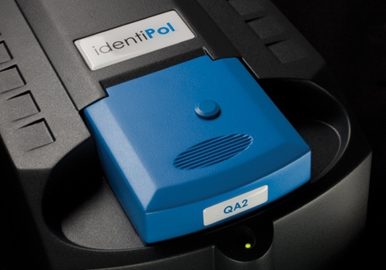IdentiPol QA2 application for biomedical material assessment
이 초록 및 포스터 자료는 골절 치유에 사용된 체온 역전 (body-temperature reverting), 가소성 형상 기억 고분자의 성능 검증에 identiPol을 이용한 유리 전이 온도 측정사례를 보여줍니다.
COMPRESSION SCREWS FOR THE FIXATION OF SMALL BONES AND BONE FRAGMENTS USING BIOCOMPATIBLE,
BIORESORBABLE, BODY-TEMPERATURE REVERTING, PLASTICISED SHAPE MEMORY POLYMERS
B.M. Thomson1 , G. Thompson1 , D. Vgenopoulos1 , K. Nair1 , J. Duncan2 , K. Howell1 , M. Martyn1 and P. Coates1
1School of Engineering and Informatics, Bradford University 2Lacerta Technology, Leicestershire
Orthopaedic compression screws promote fracture healing by drawing-together and stabilising adjacent bone fragments (e.g. Herbert screws in scaphoid repair). Shape memory polymers are materials that switch from one macroscopic shape to another following the application of external ‘triggering’ stimuli (e.g. by shrinking in length when heated).
A shape memory compression screw could therefore potentially be used to pull bone fragments together. The shape memory phenomenon occurs because when polymers solidify from a melt (or dry from solutions), the molecules form tangled networks in which individual molecules adopt conformations with the lowest available energies. If a solid polymer is (i) heated to a temperature above the point where the polymer chains are able to begin to move relative to one another (called Tg) but below its melting point; (ii) stretched; and then (iii) rapidly cooled below Tg without releasing the tension, then the polymer’s chains become ‘locked’ into energetically unfavourable conformations, (analogous to frozen, stretched rubber bands). As long as the polymer remains below Tg then its molecules remain locked in these energetically unfavourable conformations. However, if the polymer is heated above Tg, then molecules will move relative to one another and revert to their original energetically favourable conformations (e.g. re-heating a stretched shape memory polymer above Tg will cause it to shrink in length).
The biocompatible, bioresorbable polymer polylactic acid can show shape memory properties and could therefore potentially be used to make a shape memory compression screw. Unfortunately, the triggering temperature required to initiate shape reversion in unmodified PLA is too high to be conveniently incorporated into routine clinical practice. The value for Tg for a particular polymer can be reduced by adding plasticisers, low molecular weight compounds that facilitate the movement of molecular chains within solid polymers. To identify plasticisers that can reduce the Tg of PLA to 37C (i.e. physiological temperatures), standardised mixtures of PLA, plasticiser and solvent were added to moulds and dried in a computer controlled oven to produce plasticiser-polymer films. The Tg of these materials was determined using an identiPol machine. The films’ shape memory properties were assessed by (i) heating 10 mm long pieces of film to 85C in water; (ii) stretching them to 20mm long; (iii) rapidly cooling them to 5C without releasing the tension; and then (iv) attempting to trigger shape memory reversion by brief immersion in water at 10C – 60C or more prolonged immersion in saline at 37C.
Results showed that two reportedly biocompatible plasticisers, Triacetin and Tributyl Oacetylcitrate reduced PLA’s Tg in a dose dependant manner and that shape memory reversion could occur at 37C in saline. Such materials could potentially be used to form compression screws that shrink in length post-implantation and pull bone fragments together.
Ongoing work aims to optimise the conditions required to produce the shape memory plasticised PLA. Future work will use the manufacturing and characterisation equipment available at Bradford (e.g. injection moulding, extrusion and machining) to produce compression screws from these shape memory materials.
Introduction
OBJECTIVE: Make orthopaedic compression screws from stretched Shape Memory Polymers (SMP) and promote bone healing by using SMP’s reversion force to gently pull bone fragments together
Experimental
Identify a biocompatible Polylactate-Plasticiser SMP that reverts under physiological conditions

